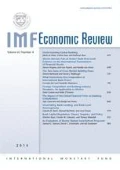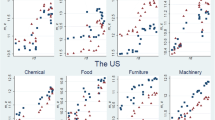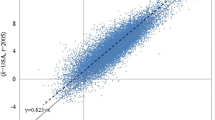Abstract
Recent empirical findings conclude that the terms of trade improve even after the positive productivity shock hits the economy among advanced economies. Corsetti, Martin, and Pesenti (2007), henceforth CMPs analytically show that a static two-country model with endogenous firm entry can generate improvement of the terms of trade in response to a positive technology shock in the form of lowering the entry cost. This paper evaluates the robustness of the results in CMP in a model with richer and more realistic dynamics such as nominal price and wage stickiness as in the Global Economy Model. It shows how the economic variables respond to the shocks that shift the production frontier outward, namely, productivity gains in manufacturing and efficiency gains in creating new firms. The main conclusions are that short-run responses could be different from those in CMP because of the existence of real as well as nominal rigidities, and that the persistence of shocks also alters the direction of responses via the wealth effect. These results suggest that it is of great importance for policy institutions to acknowledge the dynamic aspects of productivity spillovers by simulating a model with richer dynamics.







Similar content being viewed by others
Notes
Reflecting the growing interests in understanding the role of firm heterogeneity or endogenous variety in the international trade as the seminal research by Melitz (2003) represents, macroeconomists also start considering the consequences of incorporating the firm dynamics in dynamic stochastic general equilibrium models. See, for example, Bergin and Corsetti (2005); Bilbiie, Ghironi, and Melitz (2005, 2006, 2007); Fujiwara (2007); and Ghironi and Melitz (2005).
This point is predicted in Benigno and Thoenissen (2003) and Ghironi and Melitz (2005).
CMP (p. 104) set the nominal wage as a numeraire: “the exchange rate is defined as the relative price of Foreign labor in terms of Home labor units.” According to the first-order condition concerning the labor supply, namely that the marginal rate of substitution equals to the real wage, the nominal wage definitely increases as the number of firms increases. Therefore, the exchange rate appreciates and the terms of trade improve in response to the efficiency gains.
For the details of the model and simulations, please see Fujiwara and Hirakata (2007, 2008). The 2007 paper shows all the details of the model and simulation, and investigates some features not shown in this paper such as the importance of the elasticity of substitution between domestic and foreign goods for the direction of responses in international relative prices. Fujiwara and Hirakata (2008) focus exclusively on this elasticity issue in the same framework as employed in CMP.
As shown in Bilbiie, Ghironi, and Melitz (2005), regarding empirical problems associated with increasing returns to specialization and a constant elasticity of substitution production function, it may be better to model the household consuming a basket of goods defined over a continuum of goods. Neither specification, however, makes a difference in simulations conducted in this paper.
We set the Rotemberg-type adjustment cost for nominal price and wage rigidities to zero.
Note that the law of one price does not hold under the local currency pricing, the trade cost and sticky prices. In this paper we only show the terms of trade of the home country.
Because nominal rigidities have no influence on the steady state, the long-run responses in this flexible price model are the same as the baseline model. Therefore, we will not mention the long-run responses in the flexible price model henceforth.
As will be shown below, the elasticity of substitution between home and foreign products also affects the direction of the terms of trade.
In particular, in the period when the shock hits the economy, the number of firms cannot increase.
This implies that the one period lag in firm dynamics may also affect the dynamic responses for expanding the production frontier.
For details, see our accompanying paper Fujiwara and Hirakata (2007).
Responses for the shocks in the rest of the world are almost the mirror image of those for the shocks in Japan.
We assume the local currency pricing in this model. Therefore, tighter demand conditions in the domestic country do not directly feed into the price setting in the foreign country.
References
Armington, P., 1969, “A Theory of Demand for Products Distinguished by Place and Production,” IMF Staff Papers, Vol. 16, No. 1, pp. 159–178.
Benigno, G., and C. Thoenissen, 2003, “Equilibrium Exchange Rates and Supply-Side Performance,” Economic Journal, Vol. 113, No. 486, pp. 103–124.
Bergin, P.R., and G. Corsetti, 2005, “Towards a Theory of Firm Entry and Stabilization Policy,” NBER Working Paper 11821 (Cambridge, Massachusetts, National Bureau of Economic Research).
Bilbiie, F., F. Ghironi, and M.J. Melitz, editors, 2005, “Business Cycles and Firm Dynamics,” (unpublished; Nuffield College, University of Oxford).
Bilbiie, F., F. Ghironi, and M.J. Melitz, 2006, “Monopoly Power and Endogenous Variety in Dynamic Stochastic General Equilibrium: Distortions and Remedies,” (unpublished; Nuffield College, University of Oxford).
Bilbiie, F., F. Ghironi, and M.J. Melitz, 2007, “Monetary Policy and Business Cycles with Endogenous Entry and Product Variety,” in NBER Macroeconomics Annual 2007 (Cambridge, Massachusetts, National Bureau of Economic Research).
Corsetti, G., L. Dedola, and S. Leduc, 2006, “Productivity, External Balance and Exchange Rates: Evidence on the Transmission Mechanism among G7 Countries,” NBER Working Paper No. 12483 (Cambridge, Massachusetts, National Bureau of Economic Research).
Corsetti, G., P. Martin, and P. Pesenti, 2007, “Productivity, Terms of Trade and the ‘Home Market Effect’,” Journal of International Economics, Vol. 73, No. 1, pp. 99–127.
Debaere, P., and H. Lee, 2003, “The Real-Side Determinants of Countries’ Terms of Trade,” (unpublished; University of Texas, Austin).
Fujiwara, I., 2007, “Re-Thinking Price Stability in an Economy with Endogenous Entry: Real Imperfections and Product Variety,” (unpublished; Institute for Monetary and Economic Studies, Bank of Japan).
Fujiwara, I., and N. Hirakata, 2007, “Dynamic Aspects of Productivity Spillovers, Terms of Trade and The ‘Home Market Effects’,” IMES Discussion Paper 07-E-07 (Institute for Monetary and Economic Studies, Bank of Japan).
Fujiwara, I., and N. Hirakata, 2008, “A Note on ‘Productivity Spillovers, Terms of Trade and the Home Market Effects’,” (unpublished; Institute for Monetary and Economic Studies, Bank of Japan).
Ghironi, F., and M.J. Melitz, 2005, “International Trade and Macroeconomic Dynamics with Heterogeneous Firms,” The Quarterly Journal of Economics, Vol. 120, No. 3, pp. 865–915.
Hummels, D., and P.J. Klenow, 2005, “The Variety and Quality of a Nation's Exports,” American Economic Review, Vol. 95, No. 3, pp. 704–723.
Kang, K., 2005, “The Path of Export Variety and Terms of Trade,” PhD dissertation, University of California, Davis.
Krugman, P., 1980, “Scale Economies, Product Differentiation, and the Pattern of Trade,” American Economic Review, Vol. 70, No. 5, pp. 950–959.
Laxton, D., P. N’Diaye, and P. Pesenti, 2006, “Deflationary Shocks and Monetary Rules: An Open-Economy Scenario Analysis,” Journal of the Japanese and International Economies, Vol. 20, No. 4, pp. 665–698.
Melitz, M.J., 2003, “The Impact of Trade on Intra-Industry Reallocations and Aggregate Industry Productivity,” Econometrica, Vol. 71, No. 6, pp. 1695–1725.
Additional information
*Ippei Fujiwara is a director with the Bank of Japan. Naohisa Hirakata is a deputy director with the Bank of Japan. The authors thank two anonymous referees, the editor, Kosuke Aoki, Menzie Chinn, Behzad Diba, Naoko Hara, Ryo Jinnai, Doug Laxton, Dirk Muir, and Paolo Pesenti for invaluable inputs. The paper benefited from discussions with participants at the BOC Workshop on Commodity Price Issues, the Bank of Japan seminar, and the IMF Workshop on Open Economy Models for Policy Evaluation.




